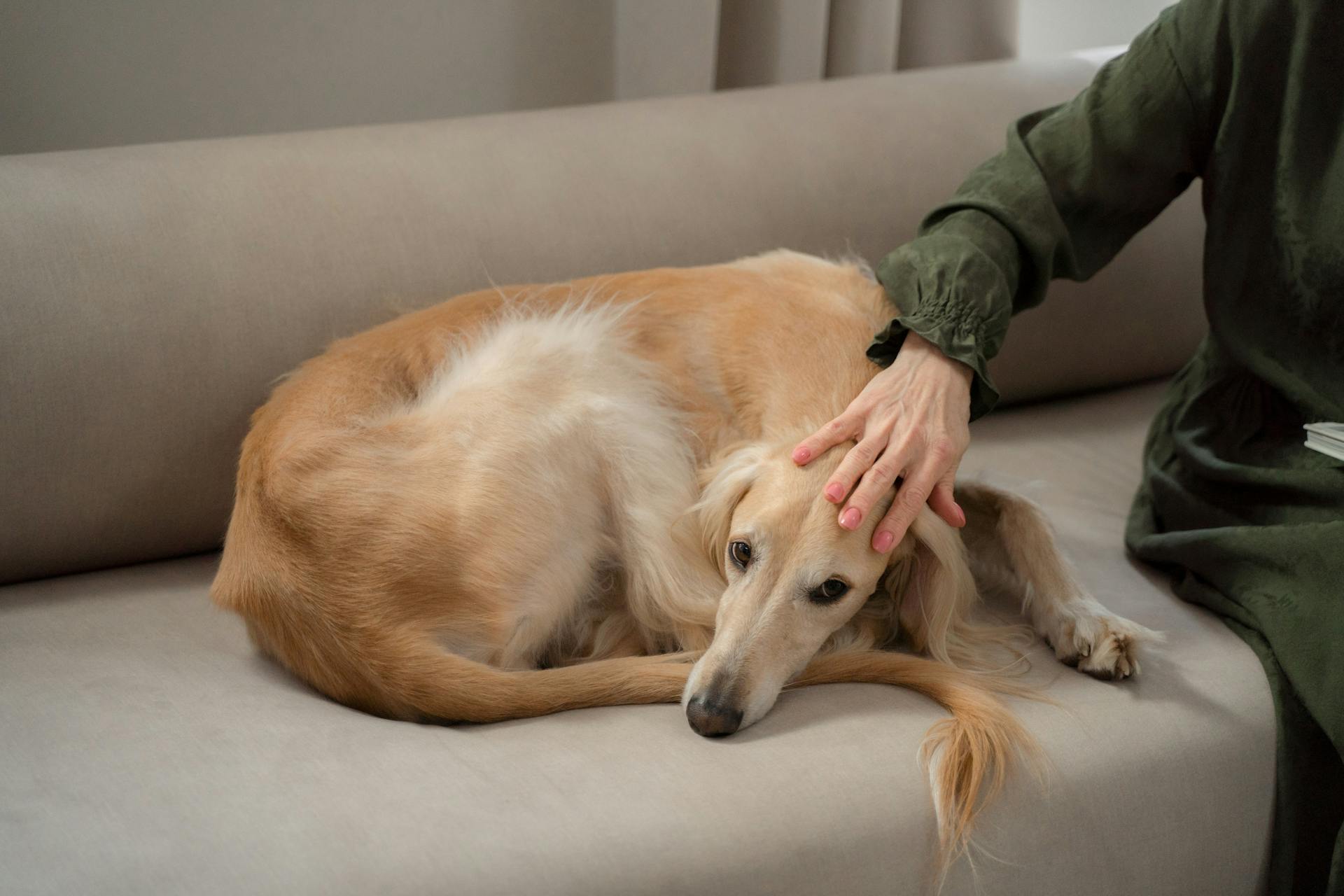
The Greyhound's ancient roots can be traced back to the civilizations of Egypt and Greece, where they were highly valued for their speed and agility.
In these early societies, Greyhounds were bred for hunting small game, such as hares and gazelles, and were often depicted in art and literature as symbols of nobility and strength.
The Greyhound's sleek physique and athletic ability made them well-suited for their purpose, and they quickly became a favorite among the aristocracy.
Their popularity continued through the Middle Ages, where they were often kept as companions by royalty and nobility, and were even used for hunting large game like deer.
Discover more: Dog Food for Hunting Dogs
Ancient Origins
The earliest recorded presence of greyhound-like dogs can be found in Ancient Egypt around 2900 BC. These dogs were often depicted in tomb carvings and artwork, showcasing their striking resemblance to modern greyhounds.
Greyhounds were highly prized in Ancient Egypt for their association with Anubis, the Egyptian god of the dead, and were commonly buried with their masters to guide them in the afterlife.
For more insights, see: Are Italian Greyhounds Hypoallergenic Dogs
The breed's presence in Ancient Greece is also significant, with the renowned Greek Playwright Xenophon praising their speed, agility, and determination in his treatise on hunting.
Greyhounds arrived in Britain around the 5th or 6th century BC, brought by the Celts from Eastern Europe, and their abilities as hunting dogs were highly prized by nobility.
The Italian Greyhound, a smaller version of the greyhound family, originated over 2,000 years ago in Greece and Turkey, as depicted in early decorative arts and archaeological discoveries.
Evidence of miniature sighthounds can be found in the ruins of Pompeii from 79 AD, showcasing the breed's presence in Southern Europe during the Middle Ages.
History and Evolution
Greyhounds have a long and storied history, with a breed standard established by kennel clubs around the world. This standard ensures they remain fit for their original work – racing.
Their physical appearance has changed over centuries of selective breeding, with adaptations that signify speed. These adaptations include a deep chest for lung capacity, a narrow body to cut through the air more efficiently, long legs for stride, and a flexible spine and long tail for balance.
Greyhounds have also undergone refinement in temperament over time, becoming known for their gentle and affectionate nature. This paired with their agility and speed makes them not only excellent racing dogs but also beloved pets.
Medieval Roles

During medieval times, greyhounds were primarily kept by nobility as hunting companions. They were highly valued for their speed and skill in hunting, which made them a symbol of aristocracy.
The term "Greyhound" emerged during this period, possibly derived from the old English "grei-hundr", meaning high-grade or high-class dog. This reflects the breed's association with nobility.
Greyhounds were frequently featured in coat-of-arms and heraldic crests, signifying their nobleness. This further solidified their connection to the aristocracy.
Here are some notable greyhounds from medieval times:
- Master McGrath, an Irish Greyhound, won the Waterloo Cup coursing event three times in the late 19th century.
- Mick the Miller, an Irish-born dog, won the English Greyhound Derby in 1929 and 1930, setting numerous records.
The greyhound's speed and agility made them a popular choice for hunting and coursing. Their association with nobility has endured throughout history, reflecting their esteemed status.
Breed Standard and Evolution
The Greyhound breed has undergone significant changes over the centuries due to selective breeding. This has resulted in a sleek and slim breed with adaptations for speed.
Greyhounds have a deep chest for lung capacity, a narrow body to cut through the air more efficiently, long legs for stride, and a flexible spine and long tail for balance. These physical attributes make them well-suited for racing.
The breed standard established by kennel clubs around the world describes the ideal characteristics, temperament, and appearance of the breed. This ensures that Greyhounds are fit for their original work – racing.
Greyhounds are known for their gentle and affectionate nature, which makes them not only excellent racing dogs but also beloved pets. Their temperament has been refined over time through selective breeding.
The Greyhound breed has a long and storied history, with some individuals attaining individual fame for their speed, bravery, and unique stories.
Coursing
Coursing is a traditional use of greyhounds that dates back to the British Isles and Europe. They were originally used to chase deer for meat and sport.
Greyhounds were later specialized for competition hare coursing in Britain. This practice was a popular sport among the aristocracy and was the predecessor to modern greyhound racing.
Some greyhounds are still used for coursing today, although artificial lure sports like lure coursing and racing are far more common and popular. Many leading sprinters have bloodlines that can be traced back to Irish sires.
The Irish Coursing Derby and the Irish Cup were notable events that featured greyhounds with strong coursing backgrounds.
Italian Greyhound
The Italian Greyhound is the smallest of the gazehounds, a family of dogs that hunt by sight. It's believed to have originated over 2,000 years ago in Greece and Turkey.
This ancient breed has a rich history, with evidence of miniature greyhounds found in early decorative arts and archaeological discoveries. The Italian Greyhound is not a bred-down version of the Greyhound, but rather shares common ancestors.
The breed's small size is a result of selective breeding, and it's been a favorite of the nobility in Italy, particularly in the 16th century. Today, the Italian Greyhound is a talented, multi-purpose dog that excels in performance events like dock diving and agility.
Italian Greyhound
The Italian Greyhound is the smallest of the gazehounds, a family of dogs that hunt by sight. This ancient breed has been around for more than 2,000 years, originating in Greece and Turkey.
The Italian Greyhound's history is shrouded in mystery, but it's believed to have originated from miniature greyhounds depicted in early decorative arts of Greece and Turkey. Archaeological discoveries of small greyhound skeletons support this theory.
There's no documented evidence of the Italian Greyhound's exact purpose, but it's likely that it was bred for both hunting and companionship. This is evident from ancient decorative art hunting scenes and family portraits featuring small greyhound-type dogs.
The Romans brought sighthounds from the Middle East and Greece into their homes around 200 BC to 200 AD, giving rise to the small Greyhounds of Italy. Evidence of miniature sighthounds can be found in the ruins of Pompeii from 79 AD.
By the Middle Ages, the breed had spread throughout Southern Europe, becoming a favorite of the Italians in the 16th century. The nobility often owned Italian Greyhounds, which were valued for their companionship.
The Italian Greyhound is not a bred-down version of the Greyhound, but rather a distinct breed with common ancestors. This is evident from the breed's written standard, which was created in 1900 using Stonehenge's writings.
Today, the Italian Greyhound is a talented and versatile dog, excelling in various performance events like dock diving, lure coursing, and agility.
Broaden your view: Merrick Dog Food for Small Dogs
Origin and Significance
The Italian Greyhound's origin story is fascinating, and it's closely tied to the Greyhound breed. The Greyhound breed's origins can be traced back to Ancient Egypt, around 2900 BC.
These ancient dogs were not identical to the modern Greyhounds we see today, but their predecessors. In ancient Egyptian art, they're often depicted as having a slender, elongated body and strong muscular limbs.
The Greyhound breed's presence is significant in ancient literature, with the Greeks mentioning them in some of their earliest writings. Notably, the Greek Playwright Xenophon praised the speed, agility, and determination of these dogs.
Their journey to Britain is a major chapter in their history, believed to have arrived around the 5th or 6th century BC, brought by the Celts from Eastern Europe.
Origin and Significance
The greyhound breed's origins date back to Ancient Egypt around 2900 BC, where they were depicted in tomb paintings and carvings with a slender, elongated body and strong muscular limbs.
These ancient dogs were not identical to modern greyhounds, but their resemblance to current racing greyhounds is quite noticeable.
The breed was mentioned in ancient Greek literature, with the renowned Greek Playwright Xenophon praising their speed, agility, and determination.
Greyhounds' presence in Britain is believed to have arrived around the 5th or 6th century BC, brought by the Celts from Eastern Europe.
Laws were enacted in England that only noblemen could own greyhounds, highlighting their prized abilities as hunting dogs among the nobility.
Frequently Asked Questions
What does the Bible say about greyhounds?
The Bible mentions greyhounds as one of the three things that are "comely in going", highlighting their impressive physical abilities. According to Proverbs 30:29-31, greyhounds are described as swift and agile creatures.
What dog descended from greyhound?
The Italian Greyhound and Whippet breeds descended from the Greyhound. They share a common ancestry with this larger sighthound breed.
Featured Images: pexels.com


